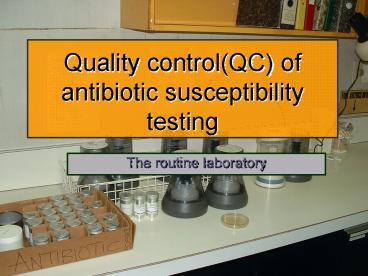Quality controlQC of antibiotic susceptibility testing PowerPoint PPT Presentation
1 / 26
Title: Quality controlQC of antibiotic susceptibility testing
1
Quality control(QC) of antibiotic susceptibility
testing
- The routine laboratory
2
A culture of QC is essential
3
Other Essential ingredients
- The Commitment
- Value of antibiotic QC
- For the patient
- The laboratory
- The Hands and Heads
- Skilled personnel
- The media
- The incubator
- The bug
- The antibiotics
- The standard operating procedures (SOP)
4
Commitment recognising the value of QC
- To monitor and ensure the accuracy and precision
of our antibiotic susceptibility testing - Allows us to rely on the reproducibility and
accuracy of our daily results - Allows communication of accurate and meaningful
results to the clinician
5
The hands and heads - personnel
- Essential that everyone is aware of the
importance of QC - Training of personnel in correct technique
- Storage of discs
- Preparation of a standard inoculum
- Swabbing of plates
- Choice and storage of media
- Timing and methods of incubation of plates
- Measurement of zone sizes
- Recording of results
Preparing a standard inoculum
6
The Media essentials
- Thickness
- pH
- Cations
- Magnesium
- Calcium
- Storage
- Dry before use
- At room temperature before use
7
Incubator
- Knowledge of requirements for incubation
- Ambient air at 350C for non fastidious aerobic
and facultative anaerobic bacteria - Timing generally 16-18 hours
- 24 hours for S.aureus and enterococci
- 5 CO2 for Haemophilus
- Stacking of plates
- No more than 5 plates high
8
The bug
- ATCC strains
- Correctly stored
- Sub-cultured regularly
- Pure culture
- Correct inoculum preparation
- Timing of swabbing
- within 15 minutes of preparing inoculum
9
Antibiotic discs
- Stored and handled correctly
- Refrigeration taken out 1 hour before use
- Expiry dates noted
- Discs at room temperature before use
- Avoid condensation
- Placing of discs within 15 minutes of swabbing
10
Decide on your procedure
- Who will do it?
- How often?
- What does the NCCLS say?
- Daily
- Weekly
- Who will assist with troubleshooting?
- Designate an individual
- How will problems be communicated to clinicians
- When?
11
When things go wrong
- Questions to ask?
- Is the procedure correct?
- Check test materials including test strains
- Check equipment
- Fridges
- Incubators
- Freezers
- Review technique of personnel
Culture of general QC in lab essential
12
Troubleshooting
13
Its Tuesday - the ENT bench reads their AST
QC..
- The ATCC strain of E.coli has been used to QC the
gram negative antibiotic panel - The zone size for Ampicillin is 10
- Accuracy limit from NCCLS is 16-22
- Zone too small
- What now?
14
Possible errors?
15
Possible errors
- Inoculum too heavy?
- Antibiotic deteriorated?
- Mueller Hinton agar too deep?
- Incorrect reading of result?
- Wrong QC strain?
16
Investigation ATCC strain E.coli 35218 was used
this is a beta lactamase producing strain
Corrective action Test repeated with correct
ATCC strain 25922 Plates clearly labelled for
future use Personnel to check labels carefully
before use
17
Blood culture bench QC performed weekly
- Monday
- New sub-culture of ATCC strain of Pseudomonas
aeruginosa - Tuesday
- AST QC performed for antibiotic panel for
Pseudomonas - Wednesday
- Plates read
- Zone sizes universally too large
Investigate
18
Possible errors?
19
Possible errors
- Inoculum too light
- Antibiotic too potent
- QC strain
- Agar too thin
- Incorrect recording of results
20
Investigation Mueller Hinton agar depth 2.5mm.
- Corrective action new batch of agar used with
correct depth of 4mm
21
Any additional action required?
22
Additional action
- If possible, results should be held back until QC
error is corrected - Significant blood culture results for patients
tested on this batch of media should be reviewed
and discussed. Repeated if required. - Highlights some of the disadvantages of weekly
testing
23
Pus bench AST QC
- This bench performs a weekly QC or whenever a new
batch of discs is opened - ATCC Enterococcus faecalis strain used to QC
trimethoprim sulphamethoxazole (TMP-SMX) - Zone too small
- ATCC S.aureus used for gram positive panel
- Zone for erythromycin too small
24
Investigation
- Quality of media should be investigated
- pH will affect macrolides, tertracyclines and
aminoglycoside - In this case the pH was too low acidic
- Ideal pH 7.2-7.4
- TMP-SMX is affected by the amount of thymidine in
media - This QC may indicate the presence of excess
thymidine in the agar which will allow the
bacteria to bypass the inhibitory effects of
TMP-SMX - Corrective action should be taken in house or
with the manufacturer and QC repeated with a new
batch
25
Your experiences
26
Some final thoughts
- AST QC needs a culture of general QC in the
laboratory - Systems for performing, recording and
troubleshooting should be documented in writing - Any errors should be investigated timeously and
systematically - Results can then be reported with confidence and
permit appropriate and safe antimicrobial use

